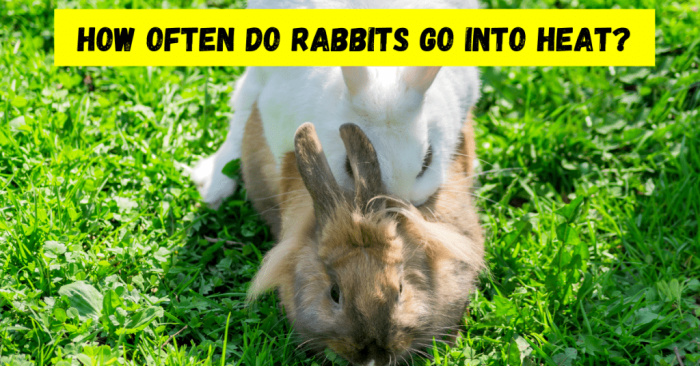The reproductive cycle of rabbits is a fascinating and complex process that plays a crucial role in the survival and continuation of the species. Female rabbits, like many other mammals, experience a specific reproductive cycle known as the estrous cycle, which involves a series of hormonal changes and behavioral adaptations that prepare them for breeding and reproduction.
In this article, we will delve into the intricacies of the female rabbit’s reproductive system, exploring the different stages of the estrous cycle, the behavioral changes associated with each stage, and the factors that influence breeding and reproduction. We will also discuss heat suppression techniques and provide guidance on managing rabbits during heat to ensure their health and well-being.
Breeding and Reproduction

Breeding rabbits is a rewarding experience that requires careful planning and preparation. Understanding the process and factors involved will help ensure a successful outcome.
Breeding Process
Breeding rabbits involves introducing a sexually mature buck (male) to a doe (female) in heat. The buck mounts the doe from behind and deposits sperm into her reproductive tract. The doe then ovulates, releasing eggs that can be fertilized by the sperm.
Factors Influencing Success Rate
- Age: Both bucks and does should be at least 6 months old before breeding.
- Health: The rabbits should be healthy and free of any diseases or parasites.
- Nutrition: The rabbits should be provided with a balanced diet to support their reproductive needs.
- Environment: The breeding environment should be quiet, comfortable, and free of stress.
Gestation and Litter Size
The gestation period in rabbits is typically around 30-32 days. The doe will build a nest and line it with fur in preparation for giving birth. Litter size can vary widely, ranging from 4 to 12 kits (baby rabbits).
Heat Suppression and Management
Heat suppression is a technique used to prevent female rabbits from entering estrus, also known as heat. This is typically done to control breeding and prevent unwanted pregnancies.There are several methods used to suppress heat in rabbits, including:* Medications: Progestin-based medications, such as medroxyprogesterone acetate (MPA), can be administered to suppress heat.
These medications work by mimicking the effects of progesterone, which inhibits ovulation and prevents estrus.
Surgery
Ovariectomy, or spaying, is a surgical procedure that involves removing the ovaries. This permanently prevents heat and eliminates the risk of pregnancy.
Natural methods
Some natural methods, such as providing a constant light source or housing rabbits in same-sex groups, can help suppress heat. However, these methods are not always effective and may not be suitable for all rabbits.
Advantages and Disadvantages of Heat Suppression
Heat suppression has both advantages and disadvantages. Advantages: * Prevents unwanted pregnancies
- Allows for more control over breeding
- Can reduce aggression and territorial behavior associated with heat
Disadvantages: * Can have side effects, such as weight gain and mammary gland enlargement
- May not be suitable for all rabbits
- Can be expensive
Managing Rabbits During Heat
If you choose not to suppress heat in your rabbit, it is important to manage her during this time. This includes providing her with a safe and comfortable environment, as well as ensuring she receives proper nutrition. Housing: During heat, female rabbits may become more aggressive and territorial.
It is important to provide her with a separate cage or enclosure where she can feel safe and secure. The cage should be large enough for her to move around comfortably and should include a litter box, food and water bowls, and a hiding place.
Nutrition: During heat, female rabbits may experience increased appetite. It is important to ensure she receives a balanced diet that is high in fiber and low in fat. You may need to increase the amount of food you give her during this time.
Summary
Understanding the female rabbit’s reproductive cycle is essential for responsible rabbit ownership and breeding practices. By gaining a comprehensive knowledge of the estrous cycle, behavioral changes, and breeding management, we can provide our rabbits with the optimal environment and care they need to thrive and reproduce successfully.
FAQ Corner
Can female rabbits go into heat?
Yes, female rabbits experience a reproductive cycle called the estrous cycle, during which they go into heat and become receptive to breeding.
How often do rabbits go into heat?
The estrous cycle in rabbits typically lasts for 14-16 days, with the heat period lasting for approximately 4-6 days.
What are the signs of a rabbit in heat?
Female rabbits in heat may exhibit behavioral changes such as restlessness, increased urination, and attempts to attract a mate.
How can I breed my rabbits?
Breeding rabbits involves introducing a fertile male rabbit (buck) to a female rabbit in heat. Successful breeding depends on factors such as the age, health, and compatibility of the rabbits.
What is heat suppression in rabbits?
Heat suppression involves using hormonal treatments or surgical procedures to prevent female rabbits from going into heat. This can be done to control breeding or for medical reasons.